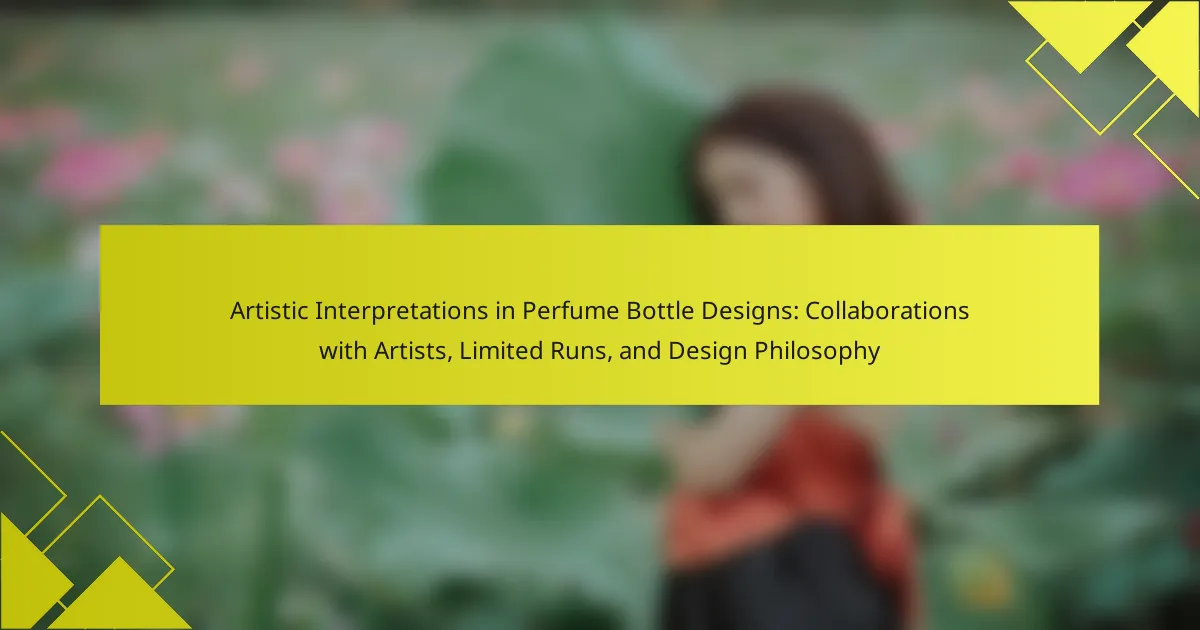![]()
What are Iconic Perfume Bottles?
Iconic perfume bottles are uniquely designed containers that hold fragrances and are recognized for their artistic and historical significance. These bottles often reflect the era and brand identity they represent. Many iconic bottles are crafted by renowned designers, such as Lalique or Baccarat, enhancing their collectible value. For example, the Chanel No. 5 bottle is celebrated for its minimalist design and has become a symbol of luxury. Iconic bottles often feature innovative shapes, colors, and materials, making them sought after by collectors. Their designs can influence contemporary packaging trends in the fragrance industry.
How have Iconic Perfume Bottles evolved over time?
Iconic perfume bottles have evolved significantly over time, reflecting changes in design, materials, and cultural influences. Initially, in ancient Egypt, perfume vessels were made from clay or alabaster. These early bottles were often simple in shape and functioned primarily for storage.
During the Renaissance, glass became the preferred material. This transition allowed for more intricate designs and decorative elements. The 19th century saw the introduction of elaborate designs, often inspired by art movements such as Art Nouveau.
In the 20th century, brands began to focus on branding through unique bottle shapes. Iconic designs, like the Chanel No. 5 bottle, became symbols of luxury. The late 20th and early 21st centuries introduced sustainable materials and minimalist aesthetics.
Today, perfume bottles are not just functional; they are considered collectible art pieces. The evolution of these bottles mirrors broader trends in art, fashion, and consumer culture.
What historical events influenced the design of Iconic Perfume Bottles?
The design of iconic perfume bottles has been influenced by several historical events. The Art Deco movement of the 1920s and 1930s emphasized geometric shapes and luxurious materials. This led to the creation of bottles that were both artistic and functional. The rise of modernism in the mid-20th century introduced minimalist designs, focusing on simplicity and elegance. Additionally, the cultural revolution of the 1960s brought bold colors and experimental shapes to the forefront. The introduction of synthetic materials in the 20th century allowed for innovative designs that were previously impossible. Each of these events shaped the aesthetic and functional aspects of perfume bottle design.
Which notable figures contributed to the popularity of Iconic Perfume Bottles?
Coco Chanel significantly contributed to the popularity of iconic perfume bottles. Her launch of Chanel No. 5 in 1921 introduced a revolutionary bottle design. The minimalist, elegant shape became a symbol of luxury. Salvador Dalí also influenced perfume bottle design with his surrealistic creations. His collaboration with the perfume industry produced unique and artistic bottles. Additionally, designers like Jean-Paul Gaultier and Marc Jacobs have created memorable bottles that reflect their fashion aesthetics. These figures transformed perfume bottles into collectible art pieces, elevating their status in the fragrance industry.
Why are Iconic Perfume Bottles considered artistic creations?
Iconic perfume bottles are considered artistic creations due to their unique designs and craftsmanship. Many bottles feature intricate shapes and artistic elements that reflect cultural and historical influences. Designers often collaborate with artists to create limited editions, enhancing their artistic value. For example, the Lalique bottle for “Champs-Élysées” showcases Art Deco aesthetics. Additionally, the materials used, such as crystal or hand-blown glass, contribute to their artistic appeal. Iconic bottles often become collectibles, valued for both their design and the fragrance they contain. This blend of function and form solidifies their status as art pieces in the realm of luxury goods.
What artistic movements have influenced the design of Iconic Perfume Bottles?
Artistic movements that have influenced the design of iconic perfume bottles include Art Deco, Modernism, and Surrealism. Art Deco, prominent in the 1920s and 1930s, emphasized geometric shapes and luxurious materials. This movement led to the creation of sleek, elegant bottles that reflected the glamour of the era. Modernism, emerging in the early 20th century, focused on simplicity and functionality. This influence resulted in minimalist designs that prioritized clean lines and innovative materials. Surrealism, which gained traction in the 1920s, inspired whimsical and imaginative bottle shapes. Designers drew on dream-like themes, creating bottles that often resembled art pieces. Each of these movements contributed to the evolution of perfume bottle aesthetics, merging art with functionality.
How do materials and craftsmanship impact the artistic value of Iconic Perfume Bottles?
Materials and craftsmanship significantly enhance the artistic value of iconic perfume bottles. High-quality materials, such as crystal or hand-blown glass, contribute to a luxurious appearance. Craftsmanship reflects the skill and attention to detail of the artisans involved. Intricate designs and unique shapes elevate aesthetic appeal. Historical context also plays a role in artistic value. For instance, vintage bottles often feature elaborate designs that represent specific artistic movements. The use of precious metals or gemstones can further increase perceived value. Overall, superior materials and craftsmanship create a unique identity for each bottle, making them collectible art pieces.
What role do Iconic Perfume Bottles play in fragrance marketing?
Iconic perfume bottles serve as crucial marketing tools in the fragrance industry. They create a visual identity that captures consumer attention. Their unique designs often reflect the brand’s image and values. This distinctiveness helps differentiate products in a crowded market. For instance, the Chanel No. 5 bottle is instantly recognizable and symbolizes luxury. Such iconic designs can enhance brand loyalty and emotional connection. Additionally, limited edition bottles often become collectible items, driving demand. This interplay between design and marketing reinforces the overall brand narrative.
How do brands use design to differentiate their Iconic Perfume Bottles?
Brands use design to differentiate their iconic perfume bottles through unique shapes, materials, and artistic elements. Distinctive bottle shapes create visual recognition and enhance brand identity. For example, the Chanel No. 5 bottle features a minimalist, geometric design that reflects luxury and elegance. Materials like glass, metal, and crystal contribute to the perceived value of the product. Artistic influences, such as Art Deco or contemporary styles, add cultural significance and aesthetic appeal. Limited editions often feature exclusive designs, increasing collectibility and desirability. These design elements work together to create a memorable consumer experience and foster brand loyalty.
What marketing strategies are associated with the promotion of Iconic Perfume Bottles?
Iconic perfume bottles are promoted through various marketing strategies. These strategies include storytelling that emphasizes the heritage and artistry of the bottles. Brands often highlight the unique designs and craftsmanship involved in creating these bottles. Collaborations with renowned artists or designers enhance their appeal. Limited edition releases create exclusivity and urgency among collectors. Social media campaigns showcase the aesthetic value and cultural significance of the bottles. Influencer partnerships help reach niche audiences who appreciate luxury items. Events and exhibitions often feature iconic bottles, allowing direct consumer engagement. These combined strategies reinforce the brand’s identity and attract both collectors and new customers.
![]()
What is the Collector’s Value of Iconic Perfume Bottles?
The collector’s value of iconic perfume bottles varies significantly based on brand, rarity, and design. Certain bottles can fetch prices ranging from hundreds to thousands of dollars at auctions. For instance, vintage bottles from renowned brands like Chanel or Guerlain often appreciate in value due to their historical significance. Limited edition releases typically hold higher value among collectors. The condition of the bottle also plays a crucial role in its market price. Bottles in pristine condition with original packaging command premium prices. Market trends indicate that demand for these collectibles has increased over the past decade. Notable sales include a 1921 Chanel No. 5 bottle, which sold for over $4,000. Collectors often seek unique designs and artistic craftsmanship, further driving up their value.
Why do collectors seek out Iconic Perfume Bottles?
Collectors seek out iconic perfume bottles for their historical significance and artistic value. These bottles often represent cultural moments and trends in fragrance design. Many iconic bottles were created by renowned artists and designers, making them collectible art pieces. Some bottles are limited editions, increasing their rarity and demand. The craftsmanship involved in creating these bottles adds to their allure. Collectors appreciate the stories behind each bottle, enhancing their emotional connection. Additionally, certain bottles can appreciate in value over time, making them a worthwhile investment. Iconic perfume bottles serve as a testament to the evolution of fragrance and design.
What factors determine the value of Iconic Perfume Bottles in the collector’s market?
The value of iconic perfume bottles in the collector’s market is determined by several key factors. Rarity significantly influences value; limited editions or discontinued bottles are often more sought after. Historical significance also plays a role; bottles linked to notable brands or events can command higher prices. Condition is crucial; pristine bottles with original packaging are valued more than those with damage. Design and artistry impact desirability; unique or aesthetically pleasing designs attract collectors. Provenance, or the bottle’s history of ownership, can enhance value, especially if it belonged to a celebrity or notable figure. Market trends and collector demand fluctuate, affecting prices over time. Lastly, authenticity is essential; replicas or counterfeit bottles significantly decrease value in the market.
How does rarity affect the desirability of Iconic Perfume Bottles?
Rarity significantly enhances the desirability of iconic perfume bottles. Limited availability creates a sense of exclusivity among collectors and enthusiasts. This exclusivity often leads to higher demand and willingness to pay premium prices. For example, vintage bottles from renowned brands can fetch thousands at auction due to their scarcity. The emotional connection to a rare item also adds to its allure. Collectors often seek unique pieces to distinguish their collections. Historical significance often accompanies rare bottles, increasing their value further. Overall, rarity directly correlates with heightened desirability in the perfume bottle market.
What are the most sought-after Iconic Perfume Bottles among collectors?
The most sought-after iconic perfume bottles among collectors include the Chanel No. 5 bottle, the Shalimar bottle by Guerlain, and the Lalique bottles for various fragrances. The Chanel No. 5 bottle is renowned for its minimalist design and historical significance since its launch in 1921. The Guerlain Shalimar bottle is celebrated for its unique shape and the brand’s rich heritage. Lalique bottles are prized for their exquisite craftsmanship and artistry, often featuring intricate designs. These bottles not only represent luxury but also have appreciated significantly in value over time. Collectors often seek these items due to their rarity and iconic status in the fragrance industry.
Which brands and designs are considered the most valuable?
Chanel No. 5 and Guerlain’s Shalimar are considered the most valuable perfume brands and designs. Chanel No. 5 has a rich history since its launch in 1921. It is recognized for its iconic bottle design and marketing strategies. Guerlain’s Shalimar, introduced in 1925, is celebrated for its artistic bottle shape. Both brands have significant collector interest. The value of Chanel No. 5 bottles can reach thousands at auctions. Shalimar bottles also command high prices, especially vintage versions. These factors contribute to their status as valuable entities in the perfume industry.
How can collectors authenticate Iconic Perfume Bottles?
Collectors can authenticate iconic perfume bottles by examining specific characteristics. Key attributes include the bottle’s design, materials, and markings. Authentic bottles often feature unique craftsmanship and high-quality glass. Collectors should check for original labels and packaging, which can indicate authenticity. Researching the brand’s history and production methods is essential. Consulting expert appraisers can provide additional validation. Online databases and collector forums may also offer insights. Provenance documentation can further confirm authenticity. These methods ensure collectors can make informed decisions.
What tips can help new collectors of Iconic Perfume Bottles?
Research iconic perfume bottles and their history. Understanding their background enhances appreciation. Join collector communities for advice and networking. Attend auctions and estate sales to find unique pieces. Verify authenticity through expert resources or appraisals. Keep a detailed inventory of your collection. This helps track value and provenance. Store bottles properly to avoid damage. Protect against sunlight and temperature fluctuations.
How should collectors care for and display their Iconic Perfume Bottles?
Collectors should clean their iconic perfume bottles with a soft, lint-free cloth. This prevents scratches and maintains the glass’s clarity. They should avoid harsh chemicals that can damage the finish. Displaying bottles away from direct sunlight is crucial to prevent fading and deterioration. A temperature-controlled environment helps maintain the integrity of the materials. Using display cases can protect bottles from dust and accidental damage. Regularly checking for leaks or deterioration is important for preservation. Proper care enhances the aesthetic and financial value of the collection.
What resources are available for learning about Iconic Perfume Bottles?
Books on iconic perfume bottles include “The Art of Perfume: Fragrance Craftsmen and Their Creations” by Michael Edwards. This book details the history and artistry of perfume packaging. Online resources include websites like Fragrantica and Perfume Society, which provide extensive databases and articles on various bottles. Documentaries such as “Perfume: The Story of a Murderer” explore the cultural significance of scent and its containers. Museums like the Museum of Perfume in Grasse, France, showcase historical bottles and their designs. Academic journals may also feature articles on the aesthetics and marketing of perfume bottles, providing in-depth analysis.
Iconic perfume bottles are uniquely designed containers recognized for their artistic and historical significance in the fragrance industry. This article explores their evolution over time, influenced by various artistic movements and historical events, highlighting notable figures who contributed to their design. Additionally, it discusses the marketing strategies associated with these bottles, their collector’s value, and factors determining their desirability in the market. Resources for further learning and tips for new collectors on authentication, care, and display are also provided.



